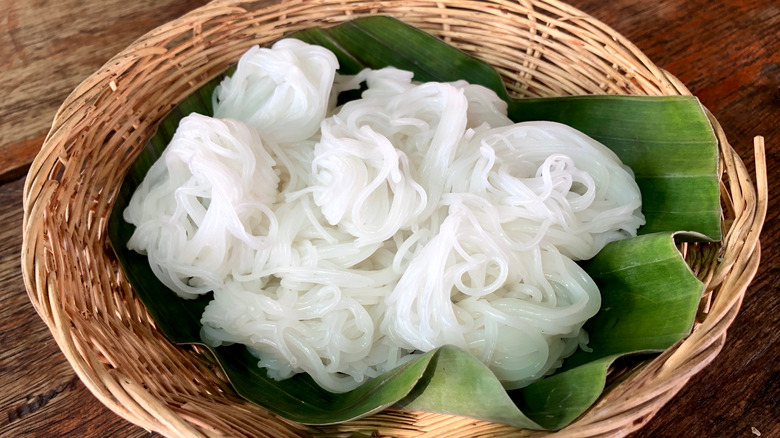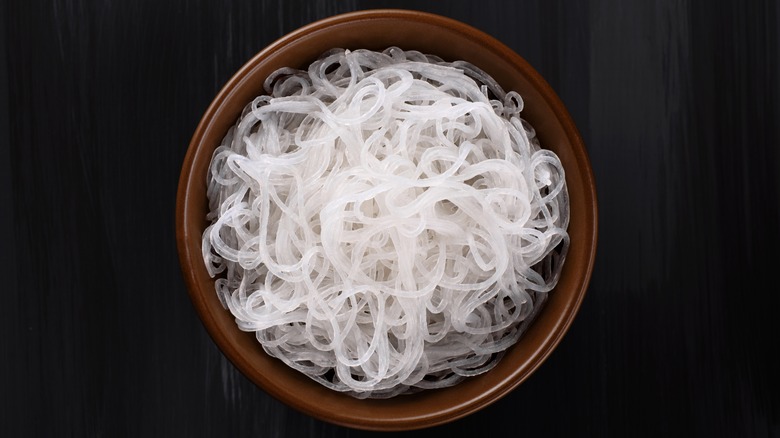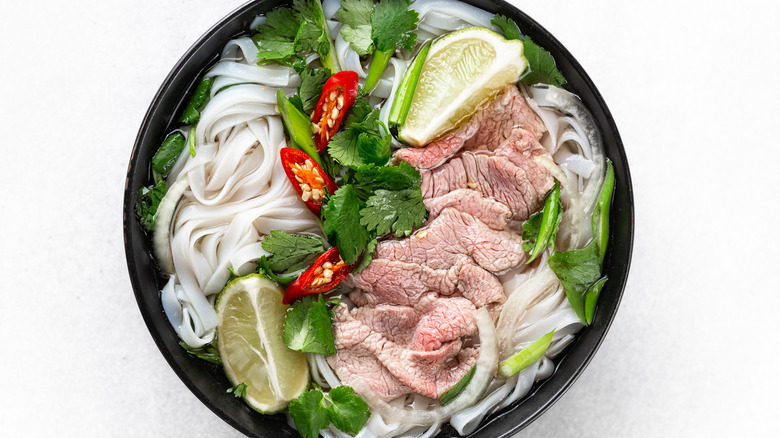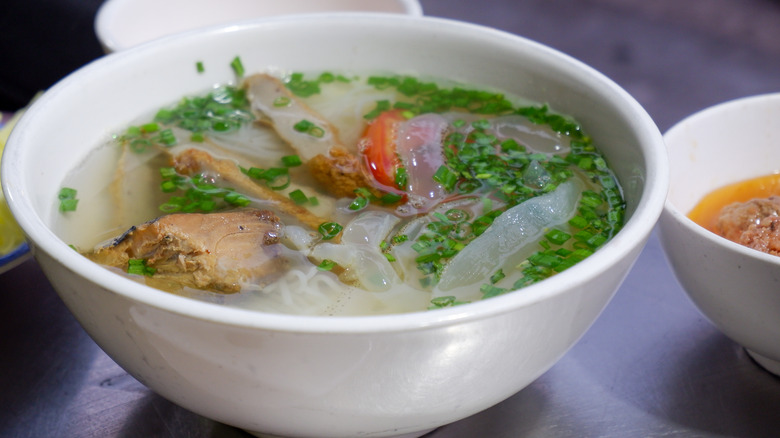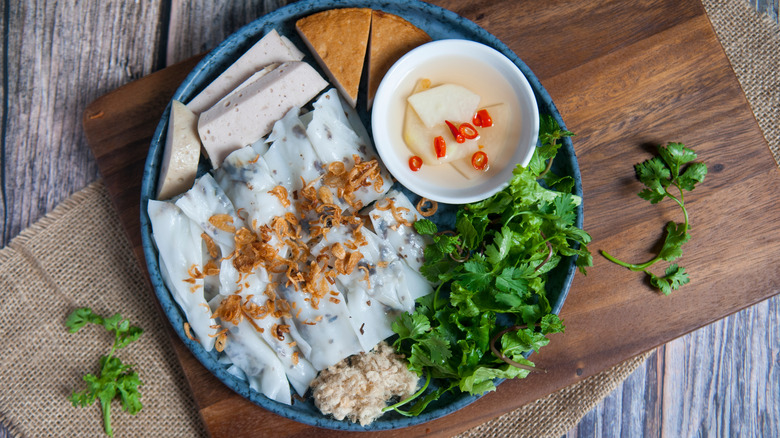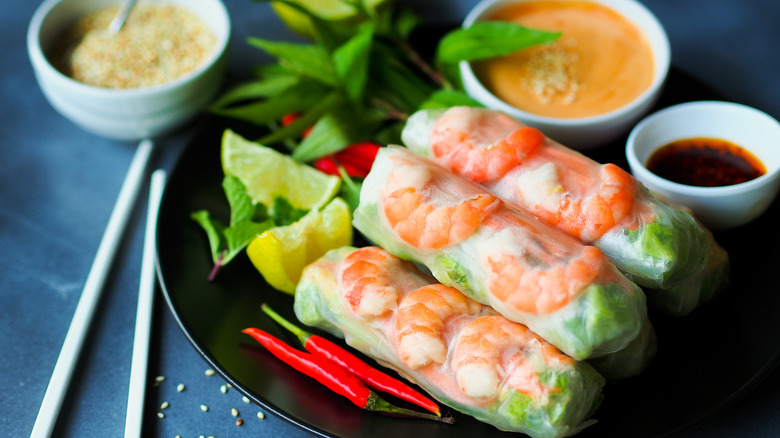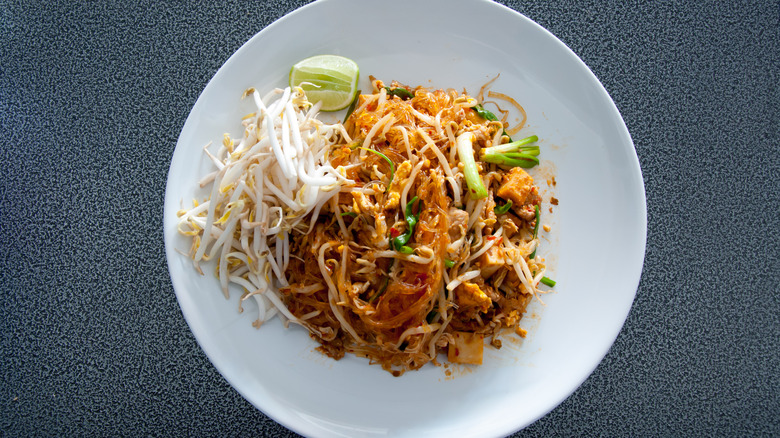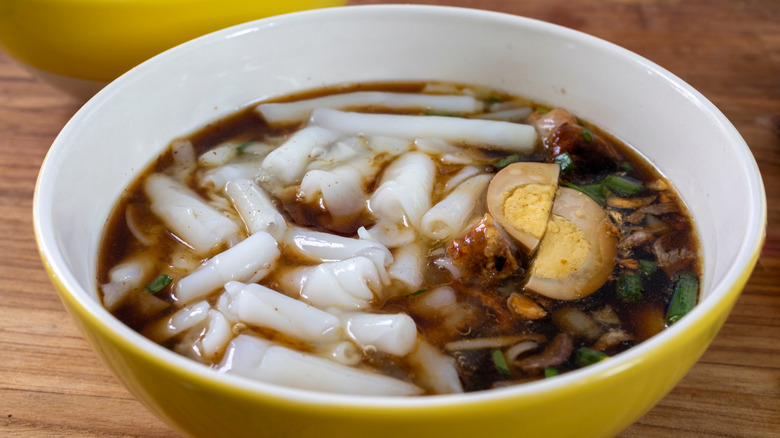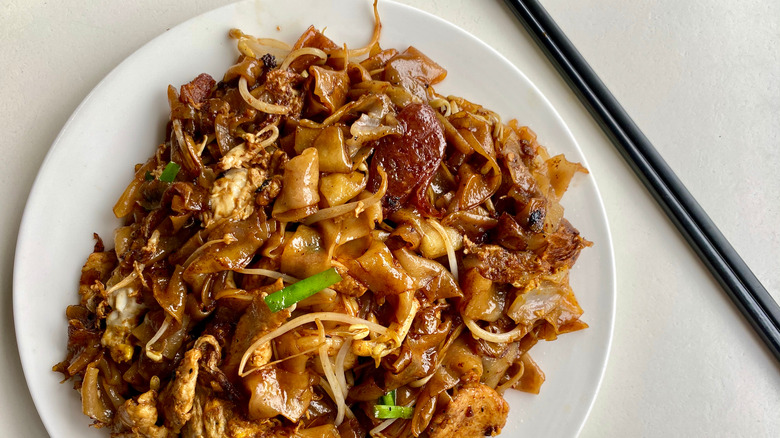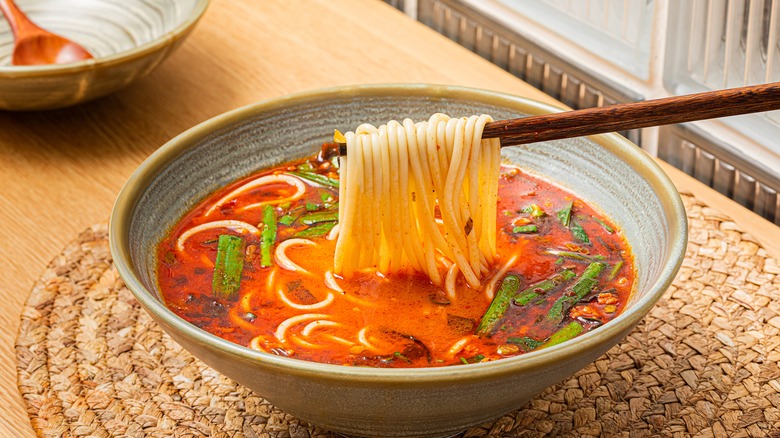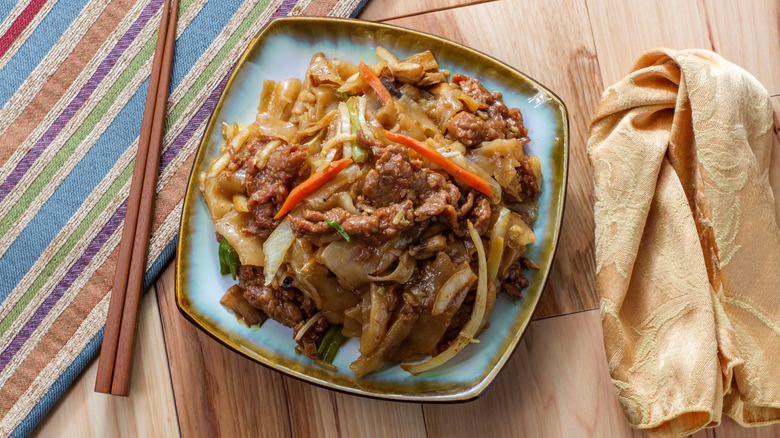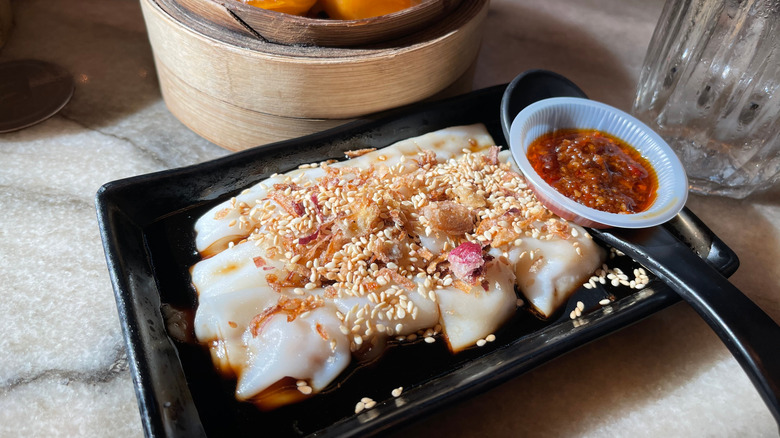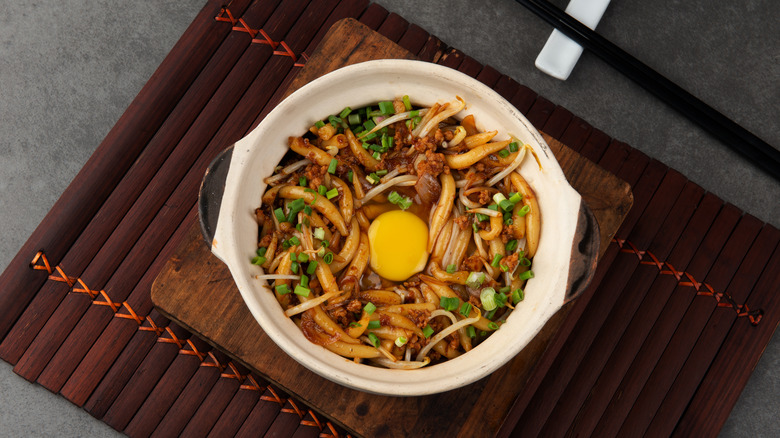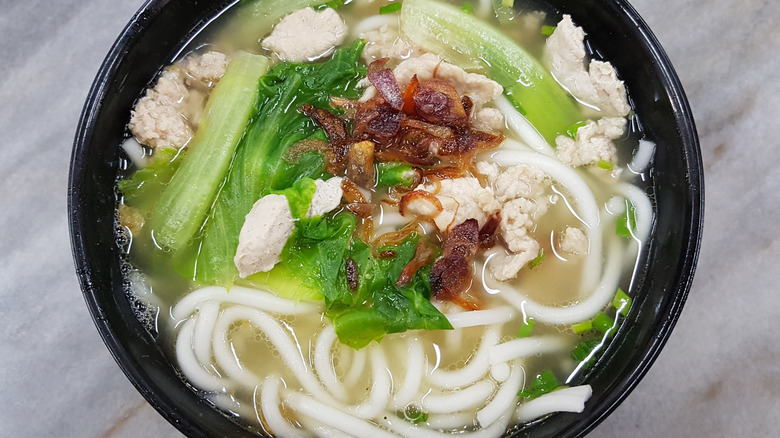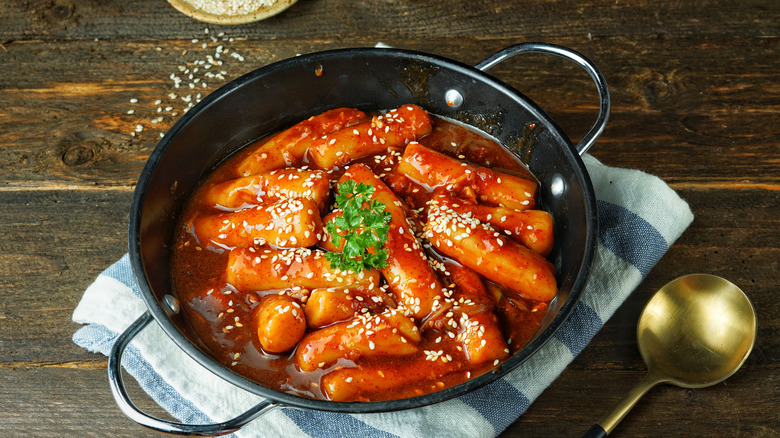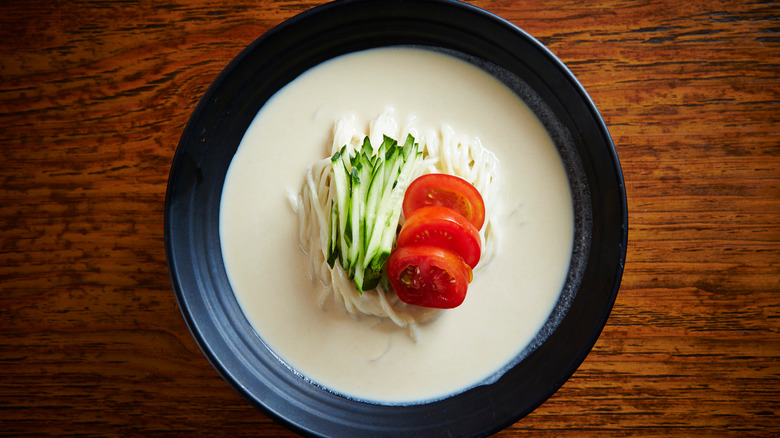15 Types Of Rice Noodles, Explained
Noodle varieties are almost endless. You can have noodles made from wheat that are chewy and dense, or noodles made from buckwheat that are grey and nutty. There are also noodles made from mung bean, zucchini, tapioca, and last but not least, rice. While there are many types, rice noodles are hot contenders in the noodle race when comparing beauty, versatility, and deliciousness.
Rice noodles are undeniably fun to eat, slurp, and chew, but have you ever taken a moment and wondered where they come from, what they are made of, and what makes them so amazingly delicious? Whether extruded through a little press that makes many noodles at once or rolled out in sheets like pasta, rice noodles come in countless varieties and make up countless more dishes.
You can find rice noodles made with glutinous rice or those that are mixed with tapioca. If you are lucky, you may even be able to find rice noodles that are fresh, and therefore, chewy, tender, and perfectly slippery. The best fresh rice noodles are either rolled, steamed, or boiled on the spot. If you are not able to find these, then opting for dry versions is also a good second choice. Dry rice noodles rehydrate well and can hold up very nicely in stir-fries and soups. Better yet, thanks to these noodles' mellow flavor and absorbent nature, they will soak up whatever sauce you put on them and become a mouthful of flavorful goodness.
Rice vermicelli
Rice vermicelli noodles are part of a larger family which contains many different variations of vermicelli from around the world. Rice vermicelli specifically, also known as bun in Vietnamese, are rice noodles that are thin, opaque, and usually very white. These noodles are delicious in stir-fries, soups, salads, and spring rolls, and will bring a nice, satisfying bite to your dishes. They also soak up sauces very well, making them the perfect vehicle for your favorite dressing like peanut sauce.
Because the noodles are so thin, they do not often require a long boiling time, if any. To rehydrate your vermicelli noodles you can simply pour some boiling water over the noodles and let them soften until they are no longer sticky and tough in the center. If you are adding them to a soup, you can also throw your vermicelli in at the last minute and serve once the noodles are perfectly tender.
Báhn pho
These noodles, as their name suggests, are used in pho. Pho is the ultimate comforting noodle soup that can be garnished with meat, vegetables, tofu, greens, and many different kinds of sauces. But regardless of what else goes in your pho, the most essential component of a good pho is the noodles. Báhn pho are slightly thick yet still flat and slightly chewy, slippery, and delightful.
While fresh báhn pho can be regularly found in noodle shops in Vietnam, it is less likely that you will be able to stumble upon these noodles in their fresh form in the U.S. However, do not lose hope — dried báhn pho is an adequate alternative to fresh báhn pho, and all you have to do is rehydrate the noodles in boiling water before adding them to your pho. You can also use báhn pho in salads because these noodles do well in both hot and cold dishes.
Bàhn canh
Another type of Vietnamese noodle, bánh canh is a chewy rice noodle that is much thicker than báhn pho. The chewiness of bánh canh does not come from glutinous rice as it does in some other noodles such as chow fun — it's actually thanks to tapioca flour. If you have ever had yuca, boba pearls, or tapioca pudding, you will understand why the addition of tapioca (also known as yuca or cassava) makes bánh canh chewy. Yuca has an inherent chewiness that makes it both delicious and great in many applications like baking and noodle making.
While bánh canh technically refers to a noodle, it is also the name of a common soup called by the same name. This soup, at its simplest, is comprised of only bánh canh noodles and a rich, flavorful pork broth. However, you can also add other ingredients like pork, shrimp, and fish balls.
Bành cuôn
These lovely, chewy, and opaque rolls are not technically noodles, but they are so delicious and very much made from rice, so we had to include them. Bành cuôn are rice crepes or cakes that are steamed and then filled with a variety of fillings like veggies, herbs, meats, mushrooms, and other proteins. They are different from bánh tráng (which are most famously used for making spring rolls) because bành cuôn are steamed and then eaten warm while they are still chewy, soft, and supple.
Furthermore, bành cuôn are thicker than bánh tráng and are often made with some percentage of tapioca flour for texture. The tapioca flour, like in bánh canh, adds a lovely chewiness that also makes the rice cakes easier to fill and roll. To make wonderful bành cuôn you need either premade bành cuôn mix or grind flour into a paste yourself. Then, this batter must be steamed in a very thin sheet and delicately removed from the steamer so that it stays intact enough to hold fillings.
Bánh tráng
The dry cousin of bành cuôn, bánh tráng are shelf stable, uber versatile, and incredibly delicious rice wrappers that can make any dinner party into the most delightful choose-your-own-adventure. How? By making gòi cuôn, of course. Gòi cuôn, which you may know as Vietnamese spring rolls, are famously made using none other than bánh tráng. Bánh tráng can be reheated at your dinner table by being dipped into a pan of hot water, and then the magic happens. Add whatever fillings you would like, maybe some rice vermicelli, cilantro, mint, shrimp, tofu, carrots, or cucumbers, and you will find yourself with fresh spring rolls perfect for dipping in peanut sauce.
In the U.S., most of the bánh tráng you can find are made in a factory, dried, and packaged for purchase in a grocery store. But in Vietnam, bánh tráng are eaten in a variety of other ways. Not restricted to only gòi cuôn, you can find bánh tráng toasted over open fires or eaten fresh with seafood.
Sen lek
Perhaps the most famous Thai dish out there, pad Thai is a fantastic triumph of taste. Hitting umami, sweet, salty, bitter, and sour, pad Thai is magical in its ability to balance all of the major tastes and hence, bring our mouths on a true flavor journey. While the sauce of pad Thai is essential, so are the noodles, and that is what we are here to talk about. Sen lek, the noodles used in pad Thai, are medium wide, thin, and hold up well in a stir fry.
Another rice noodle that is only usually available dry in the U.S., sen lek can often be found fresh in Thailand which would result in an even more tender noodle. You can also find these noodles in two thicknesses, with sen lek being the name for thinner noodles and sen yai referring to a slightly wider version.
Kuay jab
Kuay jab is another dish that refers to both a noodle and a dish. The dish kuay jab, also known as guay jub, is made with thick kuay jab noodles and many bits of pork such as pork belly, intestine, and kidney. The noodles in kuay jab are unlike some of the other noodles on this list. That's to say they are not actually very noodle-like — they are short and rolled into tight rolls. This makes the noodle very dense and wonderfully chewy.
You can find kuay jab, the dish, in two main variations. The first one, kuay jab nam sai, is made with a clear broth, while kuay jab nam kon is made with a broth that is slightly thicker and darker in color and flavor. Whichever version you are lucky enough to try, kuay jab will be sure to delight you. The wide array of textural variations makes kuay jab the perfect dish for someone who loves chewy components and a large comforting bowl of broth.
Kway teow
Kway teow noodles are strips of rice cake that have been cut apart to resemble noodles. These noodles, which are said to have originated in Guangzhou, are commonly eaten in southern Chinese cuisine as well as in other parts of Southeast Asia. Literally translating to rice cake strips, kway teow are wonderfully chewy and hold up very well in stir-fries. This makes sense considering that har kway teow derives much of its deliciousness from "wok hei", the wonderful sear that comes from a very hot wok.
While kway teow is from Guangzhou, they are most commonly known for their spotlight role in the beloved Malaysian dish char kway teow. Char kway teow is a medley of many proteins and veggies and can include things like shrimp, pork, tofu, and Chinese sausage. These components, along with the kway teow noodles, are all stir-fried together in a very hot wok and then seasoned with a sauce made from oyster sauce, soy sauce, and Shaoxing wine.
Xiǎoguō mǐxiàn
These noodles are a beloved dish in the Chinese province of Yunnan, which sits on the border of Vietnam, Myanmar, and Laos in southern China. While this province is very famous for other things, such as Yunnan's world-famous pu'er tea, xiǎoguō mǐxiàn should also be on your radar. These noodles are thick, and rather than being flat, they are circular and meaty.
Xiǎoguō mǐxiàn, like other noodles on this list, also refers to a dish that translates to small pot rice noodles. Xiǎoguō mǐxiàn as a dish is often eaten for breakfast in the city of Kunming and consists of xiǎoguō mǐxiàn noodles, pork, pickled mustard greens, and chili oil all cooked together in a rich pork bone broth. Everything is simmered together in a small pot (hence the name) and served piping hot and ready to fill empty bellies eager to start the day.
Chow fun
A delicious dish made from delicious noodles, chow fun is a wonderfully savory, salty, and very chewy dish that makes anyone feel satiated and comforted. In addition to being absolutely scrumptious, chow fun is one of the most well-known Chinese dishes available in the U.S. today. This is because when Chinese immigration to the U.S. began, the majority of people who came were from the province of Guangdong. Therefore, signature Guangdong dishes, such as chow fun, remain staples in Chinese-American cuisine.
So now, a bit more about the actual noodles. Chow fun noodles are made from rice flour and are very flat. They can be found fresh in many stores, and this is the recommended way to eat them. Rehydrating dry chow fun noodles will simply not be the same. The texture of fresh rice noodles is incomparable and will result in a final dish that is fantastically chewy, tender, and perfect. To make your slab of rice noodles more pliable you can microwave them for about 30 seconds, or run them under hot water to separate the individual layers.
Chee cheong fun
These rice rolls strongly resemble Vietnamese bành cuôn and are in fact made in very similar ways. For chee cheong fun, like with bành cuôn, you must make a batter out of tapioca and rice flour, and then steam a thin layer of the batter until it is firm and pliable. The chee cheong fun is then ready to be filled with a variety of fillings like pork, veggies, and tofu.
These rolled rice cakes are wonderfully silky in texture and, thanks to the tapioca, have a slight chew that makes them fun and satisfying to eat. You can find chee cheong fun most easily at dim sum restaurants because these wonderful rolls are traditionally eaten as part of a dim sum feast. To truly enjoy your chee cheong fun, make sure to have it alongisde a Chinese donut or some pork floss. Both of these pairings will bring even more texture and a lovely savoriness to every bite.
Silver needle noodles
Silver needle noodles, as their name suggests, are in the shape of needles. But unlike the name suggests, these noodles are not silver. Instead, they are slightly translucent and very chewy, which makes them hugely popular across Southern China and beyond. Originally from the Hakka people, but now also associated with Guangzhou cuisine, silver needle noodles are less like noodles and are more short torpedoes that are very chewy and filling.
These noodles used to be made from rice that was then blended into a paste and boiled. However, today it is more common to find silver needle noodles that are made partly or entirely from wheat. The addition of wheat makes the silver needle noodles shinier, somewhat translucent, and almost silvery. If you make your own silver needle noodles at home, then feel free to add rice flour. You can also use other starches like corn starch or tapioca starch to achieve an even chewier texture.
Lai fan
Known as lai fan in China and laska in Malaysia, these noodles are long, white, and slightly chewy thanks to the rice flour. You can find these noodles in stir-fries with meat, seafood, or other proteins, or also in bowls of curry or soup. Their chewy texture and subtle flavor make them the perfect noodle to choose when looking for a soup noodle or an addition to a salad.
If you are going to eat lai fan cold, make sure to coat the noodles in a drizzle of oil. Anytime you cook rice noodles (and wheat noodles too, for that matter), it is important to coat them in fat before letting them sit. This will allow the noodles to maintain their shape rather than sticking together as a clump. You can serve lai fan noodles in salads with vegetables and any sauce that tickles your fancy.
Tteok
Perhaps the chewiest noodle on this list, tteok are technically rice cakes that are eaten in countless ways. These little noodles are mouthfuls of happiness and the wonderful chewiness of each tteok will make your teeth stick, and smile. You may be most familiar with tteok from the dish tteokbokki, which is a Korean rice cake dish featuring tteok smothered in a red, spicy sauce.
Tteokbokki is sweet, spicy, savory, and absolutely mouth-watering. If you have had this wonderful meal you will know how delicious tteok are, and why you need to stock up on these rice cakes. You can find them in the freezer section of many stores, and they are also available dried. If you can only find the dried version then make sure to either bake or boil the tteok all the way through so that you get the ultimate chew that these rice cakes are loved for.
Migan
The history of migan noodles is long and complicated, and like many histories, it involves the mixing of many cultures and outside influences. Migan noodles originated in the Chinese province of Yunnan, and are commonly eaten for breakfast with a sweet peanut sauce or in soy milk. However, in Taiwan, migan noodles are often eaten as a savory meal with pork or eggs.
This goes to show how much a dish and simple ingredient can change from region to region. Cultural exchange through media, trade, or migration can bring many new flavors, techniques, and dishes to new parts of the world and that is exactly what happened with the migan noodle. Yunnan, which has historically been a major crossroads for East and Southeast Asia, has also seen its culture and food spread to many parts of the globe. This type of cultural transformation that happens with food is best of all because we can all relate to wanting to eat well, surrounded by good company.
